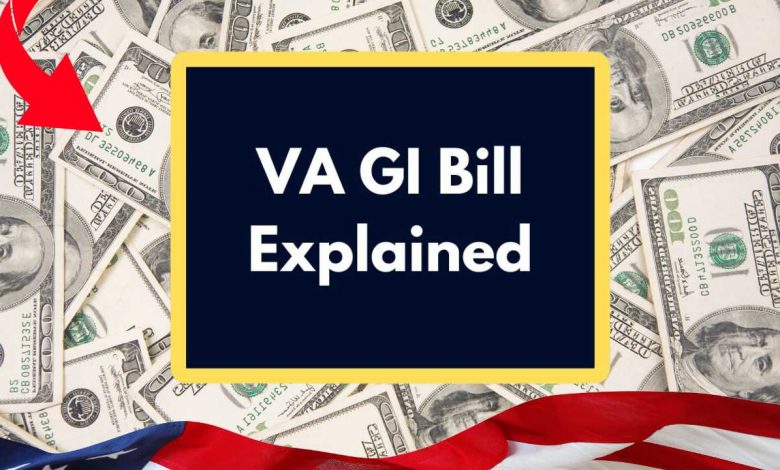VA GI Bill Explained – Benefits, Coverage, and Impact on Veterans

The VA GI Bill offers a valuable educational benefit to eligible veterans, including those in Selected Reserve, Active Duty, and National Guard. It’s designed to help cover the expenses of training or education—whether you’re pursuing degree programs, certificate courses, or even specialized vocational programs like flying or apprenticeships.
The bill can also support dependents of qualified veterans, ensuring that families are included in the opportunity for a brighter future. This assistance is meant to help reduce the financial burden, making education more accessible to those who have served in the military.
The MGIB-SR program is a key part of this benefit for Selected Reserve members, while Chapter 30 offers a widely recognized application of the GI Bill for veterans. Depending on the eligibility and conditions, this benefit can be used for up to 36 months. If necessary, remedial, refresher, or deficient training may also be included under the program.
The overview of the components and maximum duration of benefits ensures that veterans and service members have the resources they need for their educational journeys, whether through traditional classroom settings or independent study programs.
VA GI Bill Explained
The GI Bill was created after many veterans returning from World War II had difficulty finding work. Initially known as the Servicemen’s Readjustment Act of 1944, it offered unemployment benefits, insurance, and low-interest business and mortgage loans, along with cost-of-living stipends and access to education grants and VA hospitals.
Over time, the GI Bill expanded to help individuals reintegrate into civilian life through higher education, certification programs, and vocational training, addressing the ongoing struggles of veterans.
Most veterans can use their Post-9/11 GI Bill benefits for up to 15 years, but those who left active duty after Jan 1st, 2013, can extend the benefits for a lifetime under the Forever GI Bill. This bill, signed by President Donald Trump in 2017, expanded benefits to include work-study programs, lowered some qualifying requirements, and enhanced campus support for veterans.
On the other hand, the Montgomery GI Bill benefits will expire after ten years, offering a shorter time frame for veterans to use their benefits.
Overview of Veteran Affairs GI Bill
Article on VA GI Bill Explained for veterans.
Department: US Department of Veterans Affairs, USA.
Country: United States of America, Veterans’ benefits program.
Year: 2025, latest updates on veterans’ assistance.
Beneficiaries: Based on individual military service and eligibility.
Category: Finance, related to veterans’ education and benefits.
Official Website: va.gov for veterans’ services and information.
What is the VA GI Bill?
The VA GI Bill is a key education benefit for military service members in the US, offering support for job training or post-secondary education. It was originally designed to help veterans transition back to citizen life, providing them with the resources and skills needed to succeed.
Today, nearly 25 million recipients have received about $400 billion through the program. The Post-9/11 GI Bill and Montgomery GI Bill provide different benefits for Active Duty and Selected Reserve members.
- Post-9/11 GI Bill: Education benefits for military members after September 11th, 2001.
- Montgomery GI Bill Active Duty: Provides funding for training and education after serving at least two years on active duty.
- Montgomery GI Bill Selected Reserve: Offers 36 months of education and training benefits for members of the Reserve.
Eligibility for Veterans Affairs GI Bill
To qualify for the VA GI Bill benefits, the beneficiary must meet certain criteria based on their military service. For the Post-9/11 GI Bill, veterans need at least 90 days of aggregate AD service after 10th Sept 2001 or 30 continuous days if discharged due to a service-related disability.
- Montgomery GI Bill requires $1200 in the first year of service and a minimum of 2 years on active duty.
- Meeting the criteria ensures eligibility for the benefits provided by the program.
VA GI Bill Rights & Coverage
The GI Bill offers complete rights and coverage for educational expenditures, helping veterans pay for school and job training. It covers a range of costs and benefits for eligible beneficiaries and their family members. The benefits extend to various educational expenses, from tuition to housing.
- It provides housing allowances based on school location.
- A stipend of up to $1000 yearly is available for textbooks and supplies.
- Those moving from highly rural areas can receive a one-time payment for relocation assistance.
- Tuition and fees can be covered up to 100% for in-state tuition at public schools.
- The Yellow Ribbon Program helps pay for extra tuition costs at private schools and other foreign institutions.
How to Apply for VA’s GI Bill?
Applying for the GI Bill is simple and can be done online through the VA’s eBenefits portal, which is the fastest and most suitable way to check your eligibility for education benefits. Here’s how to apply:
- Go to the VA’s eBenefits portal and login to your account.
- Fill out the application for the VA GI Bill and make sure to attach documents like your DD-214 discharge papers and education histories.
- Use the VA GI Bill Comparison Tool to check eligibility and fulfill the criteria.
- If you prefer, you can mail a paper application (VA Form 22-1990).
- After filling out the application, review it carefully and submit.
- Once your application is accepted, you’ll receive a Certificate of Eligibility, which you can then submit to the school’s VA office.
Additional Resources for Veterans and Families
If you’re looking for more information or assistance with your VA GI Bill application or any related benefits, there are several resources available. The U.S. Department of Veterans Affairs offers dedicated support through their regional offices, as well as online through the VA.gov website.
You can also contact your school’s veterans’ affairs office, which often provides assistance with navigating the application process and understanding benefits. Additionally, various veteran advocacy groups provide free guidance and can help you make the most of your GI Bill benefits.
Tips for Maximizing Your GI Bill Benefits
To make the most out of your VA GI Bill benefits, consider these helpful tips:
- Plan your education path early: Take time to choose a program that aligns with your long-term career goals.
- Understand the benefits duration: Be aware of how long your benefits last and plan your educational timeline accordingly.
- Use the Yellow Ribbon Program: This program can help cover additional tuition costs at private schools or non-public institutions, giving you greater flexibility.
- Stay informed on policy changes: The rules around eligibility and benefits are updated regularly, so it’s important to stay current on any new legislation that may affect your benefits.
Common Mistakes to Avoid When Using the VA GI Bill
Many veterans encounter issues when using their GI Bill benefits, often due to simple mistakes. Here are some common pitfalls to avoid:
- Missing deadlines: Ensure that your applications and required documents are submitted on time.
- Not verifying eligibility: Double-check that you meet all eligibility criteria before applying.
- Overlooking additional benefits: Remember that the GI Bill offers more than just tuition assistance, including housing allowances, book stipends, and more.
- Not using the comparison tool: The VA’s GI Bill Comparison Tool can help you understand your benefits and compare schools, ensuring you make the most informed choice.
Frequently Asked Question
What is the VA GI Bill?
The VA GI Bill is an education benefit program for U.S. military veterans, active-duty service members, and their families, covering costs for higher education, vocational training, and certifications.
Who is eligible for the VA GI Bill?
Eligibility depends on service type and duration. For the Post-9/11 GI Bill, veterans need at least 90 days of active duty post-9/11 or 30 days if discharged for a service-connected disability. The Montgomery GI Bill requires two years of active duty and a $1,200 contribution during the first year.
What does the VA GI Bill cover?
The GI Bill covers tuition, housing, books, supplies, and relocation assistance. It also includes the Yellow Ribbon Program for additional tuition costs at private or out-of-state institutions.
What is the difference between the Post-9/11 GI Bill and the Montgomery GI Bill?
The Post-9/11 GI Bill offers benefits like housing allowances and relocation assistance for those who served after 9/11. The Montgomery GI Bill provides education benefits for active duty and reserve members and requires a $1,200 contribution.
How long do I have to use my VA GI Bill benefits?
Post-9/11 GI Bill benefits expire 15 years after service, unless discharged after January 1, 2013, granting lifetime eligibility. Montgomery GI Bill benefits expire 10 years after discharge.
Can dependents use GI Bill benefits?
Yes, under the Post-9/11 GI Bill, service members can transfer unused benefits to their spouses or children, supporting their educational goals.
What is the Yellow Ribbon Program?
The Yellow Ribbon Program helps cover additional tuition and fees not covered by the Post-9/11 GI Bill for private, graduate, or out-of-state education.
Can the VA GI Bill be used for non-traditional education programs?
Yes, it supports vocational training, apprenticeships, flight training, online programs, and remedial or refresher courses if needed.
How do I apply for VA GI Bill benefits?
Apply online via the VA’s eBenefits portal or submit a paper application (VA Form 22-1990). Provide documents like your DD-214 and education history to receive your Certificate of Eligibility.
Are there additional resources to help with the GI Bill?
Yes, veterans can access support through VA.gov, regional VA offices, school veterans’ affairs offices, and advocacy organizations to navigate and maximize their benefits.
Conclusion
The VA GI Bill is an incredible benefit that can significantly enhance the quality of life for veterans and their families. Whether you’re pursuing a degree, certification, or specialized training, the educational support it offers can open doors to new opportunities. By staying informed, planning carefully, and using all available resources, veterans can maximize their GI Bill benefits and ensure they are well-equipped for life after service.
Remember, the VA is here to help, and there are many organizations dedicated to supporting veterans through their educational journeys. Don’t hesitate to reach out and make the most of the opportunities available to you.



